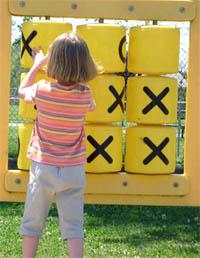What Children Need to Know
If They are Lost
Teach your children what to do if they get lost in a store or other public place. For example, in a store situation, they should contact an employee at a cash register or customer service desk.
Make sure your child knows his/her full name, address, phone number, and his/her parents’ names.
Explain to your child that most stores have a public address system so they can page the parents to come to wherever the child is found. Tell your children to never leave the store if they get lost.
Internet and Phone Safety
The Internet, email and chat rooms can pose dangers to your children. Criminals who pose as children may try to communicate with your children. They may say they are 10 years old, but they may actually be a 35 year old trying to find out information about your children. We recommend that you supervise your children when they are on the computer. Tell them never to give out any information about themselves, their family, their home, their school, etc.
The same thing applies to answering the telephone. Children should never give out any information, and should also not tell a stranger they are home alone. They may say their parents can’t come to the phone right now, or better yet, let the answering machine screen incoming calls so they can choose which people to talk to.
Avoiding Strangers
Teach your children that a stranger is anyone they do not know very well. Stress the fact that strangers can be male, female, young, old, dirty, clean cut, etc. A stranger can be someone they see everyday in the neighborhood. Make sure they understand that most strangers are good people, not bad people.
Tell them how important it is to keep a safe distance from strangers. Explain that adults can move and cover ground very quickly, so it is important that children begin to move away from strangers before they get too close.
Teach children to stay away from people in vehicles, and to never get into a vehicle with a stranger.
Teach children to walk on the sidewalk against traffic so it is easier to see strangers who are approaching in cars. If they have to run away, teach them to run in the opposite direction of traffic so the stranger will either have to back up or turn the vehicle around to follow them.
Children should use the buddy system whenever possible. Kids who are alone are much more likely to be a target.
Teach kids about the “tricks” strangers may use to lure them away. These include offers of candy or money, asking for help in finding an address or a lost pet, or saying their parents were in an accident and they were sent to pick them up.
Parents and children should agree on a “secret code word” in case the parents have to send someone else to pick them up in a real emergency. Even then, it is a good idea for children to have a trusted adult verify the emergency situation.
Getting Away from Strangers
If children are playing in the front yard and a stranger in a vehicle or on foot begins to approach them, make sure the children know to run back in the house, lock the door, and tell an adult what happened. This same principle applies at school. They should run to the closest classroom or office and seek assistance.
Children should know what to do if a stranger confronts them. If a child is approached or bothered by a stranger, their main objective should be to get away fast and run to a safe place where a responsible adult can help them. They also need to know how important it is for them to tell an adult what happened and to report the incident to the police as soon as possible.
If a stranger attempts to grab your child, let them know that it is okay for them to punch, kick, scratch, bite, etc., in order to get away from that person. However, make sure they understand that prevention, not physical resistance, is the most important thing that will keep them safe. In most cases, an adult can easily overpower a small child who is physically resisting.
If someone tries to bother or abduct your child in a public place, your child should know that it’s okay to “create a scene”. They need to know specifically what to say to get the attention of others around them. For example, let’s say a stranger is attempting to kidnap a child from a crowded store. If the child simply yells and screams, bystanders might assume that the child misbehaved and was being removed from the store by their parent(s). However, if the child says one or more of the following phrases, people in the area will know exactly what is happening. Make sure your child knows to speak loudly so everyone will hear it.
- “Leave me alone, you’re a stranger.”
- “Get away from me. You’re not my mother.”
- “Help me! I’m being kidnapped by a stranger.”
Teach children the difference between “good touching” and “bad touching.” Encourage them not to be afraid to talk about these issues. Make sure they understand that “bad touching” can also be done by someone who may not be a stranger.
Children should know that bad strangers might ask them to keep something “a secret”. They should not keep secrets with strangers, and they should always tell a trusted adult what happened.
Prepare Your Children
After you go over these things with your children, you should test them to see if they understood what you told them. One of the best ways to test children is to create an imaginary scenario for them and ask them what they would do. This will give you an excellent opportunity to see what they know and how they think through different problems and situations.
For example, ask your children what they would do if they were at school and a neighbor who lives down the street came to the school and said, “Your sister had an accident and had to go to the hospital. Your parents are at the hospital now and they sent me to take you there. Let’s go!”
You might also ask them what they would do if a lady approached them with a picture of a dog and a $20.00 bill in hand and said, “I lost my dog and I just have to find him. His name is Max, and I will give you $20.00 if you help me find him.”



